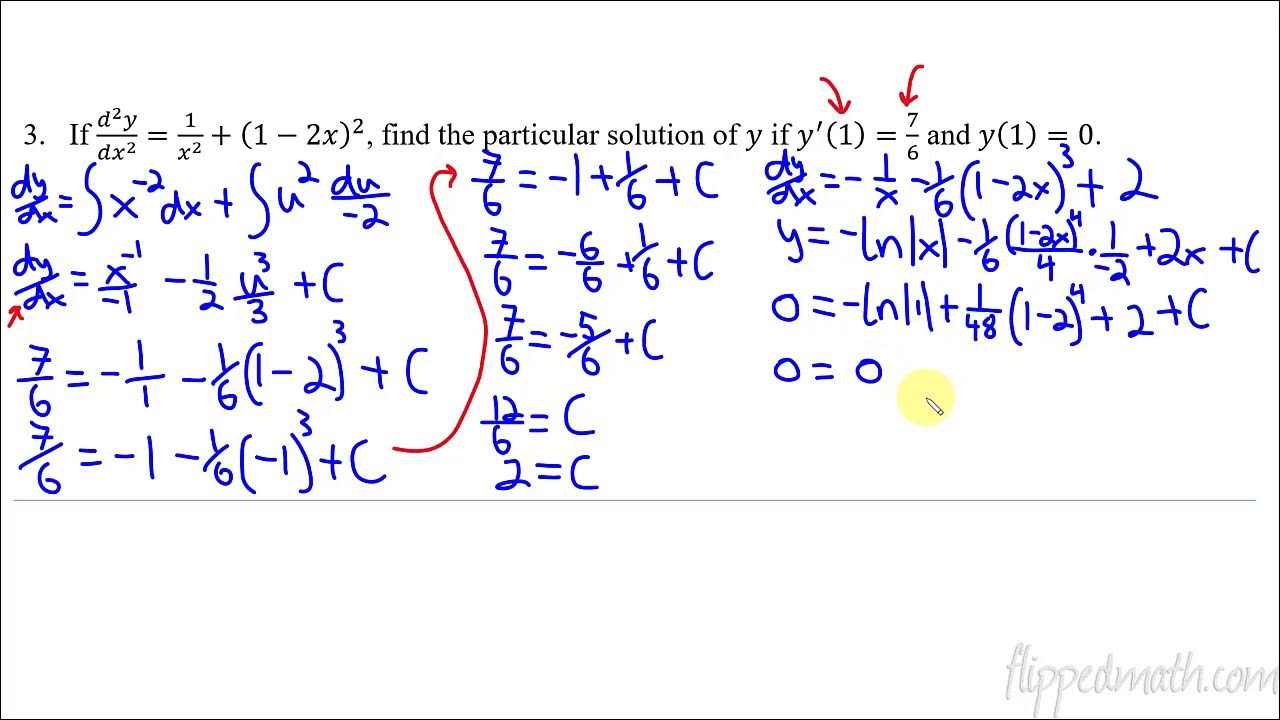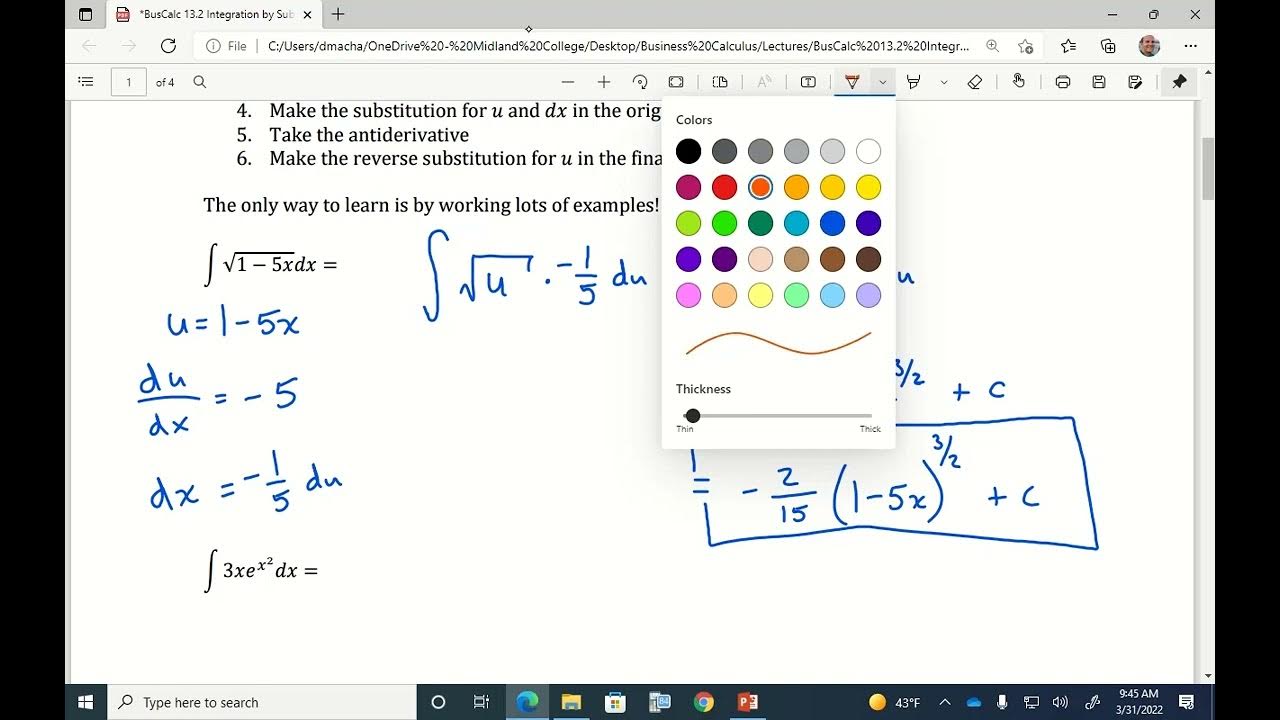Indefinite integrals of sin(x), cos(x), and e_ | AP Calculus AB | Khan Academy
TLDRThe video script discusses the concept of antiderivatives, emphasizing that they are not limited to functions of x but can apply to any variable. It explains the process of finding antiderivatives for sine and cosine functions, using the relationship between their derivatives. The script then corrects a mistake regarding the variable of integration and proceeds to find the antiderivatives of e to the power of a and 1/a, highlighting the importance of including a constant factor in the final answer.
Takeaways
- 📚 The script focuses on the concept of taking antiderivatives of basic functions.
- 🔄 It emphasizes that antiderivatives can be taken with respect to different variables, not just 'x'.
- 🌀 The antiderivative of sine (sin) is negative cosine (-cos), and vice versa, the antiderivative of cosine is sine.
- ∫ The indefinite integral of a function is the antiderivative, and it is represented with a 'plus constant'.
- 📐 When dealing with integrals, the variable of integration is treated as a constant with respect to the functions being integrated.
- 💡 The antiderivative of an exponential function e^x is the same exponential function, e^x.
- 📈 The antiderivative of 1/a with respect to 'a' is the natural logarithm of the absolute value of 'a'.
- 🎓 The importance of remembering to include a constant when stating the antiderivative of a function.
- 🔍 The process of finding antiderivatives involves understanding the relationship between derivatives and antiderivatives.
- 📊 The script provides examples to illustrate the process of finding antiderivatives for different types of functions, including trigonometric and exponential functions.
Q & A
What is the main topic discussed in the transcript?
-The main topic discussed in the transcript is the process of finding antiderivatives of various basic functions, including trigonometric and exponential functions, with respect to different variables.
Why does the speaker mention that it doesn't always have to be functions of x?
-The speaker mentions this to clarify that antiderivatives can be found with respect to different variables, not just x. In the given example, the function is with respect to t, highlighting the versatility in integration.
What is the antiderivative of sine of t?
-The antiderivative of sine of t is negative cosine of t, which can be expressed as -cos(t).
How does the speaker arrive at the antiderivative of cosine of t?
-The speaker uses the relationship between the derivative of cosine with respect to t (which is negative sine of t) to determine that the antiderivative of cosine of t is sine of t, expressed as sin(t).
What mistake does the speaker point out in the script?
-The speaker points out that there should be 'da' instead of 'dt' in the expression for integration with respect to 'a', as 'dt' would imply integration with respect to 't'.
What is the antiderivative of e to the a?
-The antiderivative of e to the a is e to the a, which can be written as e^a, since the derivative of e^x with respect to x is e^x, and this property extends to any variable 'a'.
What is the antiderivative of 1/a with respect to 'a'?
-The antiderivative of 1/a with respect to 'a' is the natural logarithm of the absolute value of 'a', expressed as ln(|a|).
Why does the speaker emphasize the importance of including a constant in the antiderivative?
-The speaker emphasizes including a constant because it's a fundamental part of the general form of an antiderivative. The constant accounts for the infinite number of possible antiderivatives due to the arbitrary constant of integration.
How does the speaker use the concept of derivatives to find antiderivatives?
-The speaker uses the concept of derivatives by reversing the process. They find the derivative of the given function and then use the relationship between the derivative and the antiderivative to find the original function, which is the antiderivative.
What is the significance of the phrase 'most general antiderivative'?
-The phrase 'most general antiderivative' refers to the fact that there are infinitely many antiderivatives for a given function, differing only by a constant. The 'most general' form includes this arbitrary constant to account for all possible antiderivatives.
Outlines
📚 Understanding Antiderivatives and Functions of Variables
The paragraph discusses the concept of taking antiderivatives of basic functions, emphasizing that it's not limited to functions of x but can also be functions of other variables like t. It clarifies the notation used in the process, highlighting the importance of using the correct variable for integration. The explanation proceeds with examples, focusing on the antiderivatives of sine and cosine functions, and how they relate to their derivatives. The paragraph also introduces the idea of indefinite integrals and how they relate to antiderivatives, using the context of definite integrals to illustrate the point.
Mindmap
Keywords
💡antiderivative
💡functions
💡sine and cosine
💡definite integrals
💡notation
💡exponential functions
💡constants
💡natural logarithm
💡derivative
💡variable
Highlights
The session focuses on taking antiderivatives of basic functions to build comfort with the process.
It's clarified that antiderivatives can be taken with respect to variables other than x, such as t.
The antiderivative of sine and cosine functions are discussed, emphasizing the relationship between their derivatives.
The derivative of cosine with respect to t is shown to be equal to negative sine of t.
The antiderivative of sine of t is identified as negative cosine of t.
The antiderivative of cosine of t is explained as sine of t, highlighting the inverse relationship between derivatives and antiderivatives.
An error in the example is corrected, shifting the focus to the correct variable a, instead of t.
The indefinite integral of e to the power of a is explored, emphasizing the unique properties of exponential functions.
The antiderivative of e to the a is shown to be e to the a, plus a constant, due to the nature of exponential functions.
The natural log of the absolute value of a is identified as the antiderivative of 1/a.
The importance of remembering to include a constant when finding antiderivatives is emphasized.
The process of taking antiderivatives is shown to be systematic and builds on the understanding of derivatives.
The session aims to make the concept of antiderivatives clear and accessible through examples and explanations.
The relationship between derivatives and antiderivatives is a central theme, with examples illustrating this connection.
The session provides a comprehensive overview of taking antiderivatives of trigonometric and exponential functions.
The practical application of antiderivatives in solving definite integrals is alluded to, setting the stage for further exploration.
The session concludes with the successful identification of antiderivatives for the given expressions, reinforcing the learned concepts.
Transcripts
5.0 / 5 (0 votes)
Thanks for rating:





